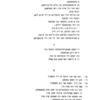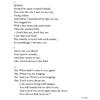1: Poem, Celia Dropkin’s “Adam,” in Yiddish and English translation, 1935.
Celia Dropkin’s poem “Odem” (“Adam”) was published first in 1935, in In heysn vint (In the hot wind), and then again, as a shortened, adapted version of the poem, in a collection which shares the same title as the first, In heysn vint (1959). Her children funded the publication of this second book, a collection of Dropkin's selected poetry, short stories, and paintings, after her death.
The poem "Odem" describes a charged encounter between two figures, mixing erotic imagery with biblical allusions. This first version of the poem is divided into three parts.
Suggested Activity: Read Kathryn Hellerstein’s translation of the poem’s first version out loud to the class or in smaller groups. Ask students: What do you know about the poem’s speaker after reading the poem? What do you know about the poem's addressee? How do you visualize Adam here? How would you characterize the poem's tone, voice, and register? How would you describe its form (meter, rhyme, structure, enjambment, etc.)? How do you interpret the final stanza? What do you think it might say about creativity, spirituality, and power? In your own words, describe the poem’s encounter. How is power divided between the two figures? What is the relationship between the three parts of the poem? What effect does the shift from first-person voice to dialogue have?
Sources: Celia Dropkin, "Odem," In heysn vint (New York: Pozy-Shaulson Press, 1935), 51-52.
Celia Dropkin, "Adam," trans. Kathryn Hellerstein, A Question of Tradition: Women Poets in Yiddish, 1586-1987. Copyright (c) 2014 by the Board of Trustees of the Leland Stanford Jr. University. All rights reserved. With the permission of Stanford University Press, www.sup.org.


